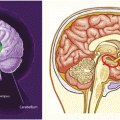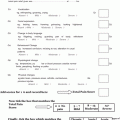© Springer Science+Business Media New York 2015
Verna Benner Carson, Katherine Johnson Vanderhorst and Harold G. KoenigCare Giving for Alzheimer’s Disease10.1007/978-1-4939-2407-3_66. Getting the Food in…and Getting it Out
(1)
C&V Care Specialists, Inc., Fallston, Maryland, USA
(2)
C&V Care Specialists, Inc., Williamsville, New York, USA
(3)
Dept. of Psychiatry Behavioral Science, Duke University Medical Center, Durham, North Carolina, USA
Keywords
Problems with and management of eatingIncontinenceManagement of incontinenceUrinary tract infectionsTraveling and incontinenceDehydrationDepression and appetite lossPain and appetite lossPureed foods’Weight lossEating and elimination are part of the same continuum—and Alzheimer’s disease (AD) impacts the entire continuum. In this chapter, we first address the issue of getting enough food into the person and how AD impacts appetite. This is a major concern for both family members and paid caregivers. They worry whether the person in their care is taking in enough calories and losing weight or is taking in too many calories and gaining weight, both of which may negatively impact their health. Perhaps the person under care is a diabetic or has any number of chronic diseases where dietary management is essential. Looking at where the person is on the functional assessment staging tool (FAST) scale, puts these issues into perspective.
With the onset of stage 6, when cognitive and functional ability is at the level of a 4-year-old deteriorating to that of 2-year-old, eating progresses through two major changes. At the beginning of stage 6, people are hungry all the time. They have very little short-term memory and quickly forget that they have just eaten. A caregiver might complain, “No sooner have I cleared away the dishes than my mother is asking me when we are going to eat! I become really frustrated with her when I need to tell her repeatedly, ‘Mom you just ate two scrambled eggs, several slices of bacon, toast and two donuts. You can’t possibly be hungry!’ What am I supposed to do—cook for her all day long?” Cooking all day is not necessary but a strategy that works in this situation is to make healthy foods such as cheese, fruits, and crackers available all day long so that the person can snack whenever he/she wants. At the end of stage 6 on the FAST scale and moving into stage 7, the person frequently refuses to eat or eats very little.
The refusal to eat is a frightening behavior to caregivers. This seems unnatural and leads to weight loss and an assortment of other health problems including increased risk for infection, reduced muscle strength, fatigue, and increased falls (Increasing links on food and depression).
Dehydration
People with dementia are also at risk for becoming dehydrated if they are unable to communicate their need for fluid, recognize that they are thirsty, or if they just forget to drink . Insufficient fluid intake can lead to headaches, increased confusion, constipation, and urinary tract infections (UTIs) . In the case of UTIs, most of those with Alzheimer’s dementia demonstrate no symptoms of a UTI. However, an untreated UTI can lead to delirium—a life-threatening condition. Negative outcomes resulting from inadequate fluid intake can worsen the symptoms of dementia. Providing a drink every 2 h throughout the day is a strategy that helps to ensure fluid intake. This will maintain hydration and may prevent constipation, UTIs, and other physiological changes that can result in delirium (Trivedi 2014).
Weight Loss
Over the course of the disease, most people with Alzheimer’s dementia generally lose weight . The loss of weight is probably due to a number of factors such as diminished appetite, depression, difficulty cooking , problems with communicating or recognizing hunger, poor coordination, tiring more easily, and problems with chewing and swallowing. Swallowing difficulties can be referred to a speech pathologist and loss of weight to the physician who can refer the patient and caregiver to a dietitian. Untreated depression, which is very common in those with dementia, may also lead to diminished appetite and weight loss.
Persons with dementia may have problems communicating hunger or dislike for the food they have been given. They may communicate their needs through behaviors such as refusing to eat or holding food in their mouth. Providing choices of foods, using prompts and pictures, sometimes help .
The presence of pain might also be a reason for refusal to eat. Untreated pain anywhere in the body can lead to a loss of appetite. However, pain due to problems with dentures, sore gums, or painful teeth often has a negative impact on eating . Oral hygiene and regular mouth checks are important.
Fatigue can also be a cause for not eating or giving up part way through a meal. Fatigue can lead to other difficulties such as problems with concentration or difficulties with coordination. It is important to be aware of this and to provide the necessary support for eating when the individual is most alert. Eating small portions more regularly is better than having set mealtimes and again, the strategy of placing healthy finger foods in a convenient location may encourage all-day snacking .
Other Causes for Diminished Appetite
Changes to medication or dosage can result in appetite changes. Likewise, lack of physical activity may directly impact appetite. Those who are sedentary may not feel hungry, whereas the person who is always on the move (pacing, wandering, etc.,) might seem hungry all the time and may need additional calories. Constipation is a common problem and can result in the person feeling bloated or nauseous, making them less likely to want to eat. Strategies to prevent constipation include encouraging activity (if sedentary), offering fiber-rich foods (vegetables and bran-containing cereals), and providing plenty of fluids (Alz site-eating tips 2013).
Strategies to Encourage a Healthy Appetite
There are many ways to stimulate appetite and interest in food and drink. First, knowing the person, his/her routines, preferences, likes and dislikes, and other needs will lead to more successful caregiving. Families should communicate this information to paid caregivers. The following are key to getting persons with dementia to eat:
Presentation of food is important. Foods that smell and look good are appealing. Sometimes providing different tastes, colors and smells may stimulate a poor appetite.
Seizing on opportunities to encourage eating as opposed to being locked into a rigid eating schedule is essential. For example, if the cared for person is awake for much of the night then night-time snacks may be a good idea.
Providing food that the person likes in small portions is often helpful.
Trying different types of food, e.g., milkshakes or smoothies (often fortified with protein) may be another way to increase the intake of calories and necessary nutrients.
Alzheimer’s may impact the way food tastes, so experimenting with stronger flavors or sweet foods may be helpful.
Food that becomes cold will lose its appeal. If the person is a slow eater, it makes sense to serve only small portions to keep food warm, or to use the microwave to reheat food.
If the person is having difficulties chewing or swallowing, serving naturally soft food such as scrambled eggs or stewed fruit might help—avoid pureed food since it is generally not appetizing.
If pureed food is necessary, speak to a dietician or speech and language therapist to discover strategies to make sure that food is not only nutritious but continues to taste good.
Involving the cared for person in the mealtime preparations—perhaps setting the table or stirring the food as it cooks—can often stimulate appetite.
Providing positive encouragement and gentle reminders to eat may help, although impatient nagging is not.
Maintaining a relaxed, friendly atmosphere with some soft music is often helpful.
Meals should be a time not only for eating and drinking but also an opportunity for social stimulation.
Providing dessert even if the person does not eat his/her entire meal is recommended—a motto for caregivers should be: “Who Says You Can’t Eat Dessert First!”
Additional Challenges
People with dementia may struggle to recognize food and drink, leading to malnutrition and dehydration . This deficit can be explained by damage to the brain, unfamiliar food, or how food is presented. If the person with dementia has problems with vision, he/she may not be able to see the food. Explaining what the food is and ensuring that the person is wearing correct glasses are helpful interventions.
Additionally, those with Alzheimer’s have limited concentration, which means they may have difficulties staying focused on a meal until it is finished. A solution to this is to serve smaller more frequent meals and/or to encourage healthy snacking. People with dementia may struggle to handle cutlery or pick up a glass. They may also have trouble getting food from the plate to their mouth. A person with dementia may not open her/his mouth as food approaches and may need to be reminded to do so. There may also be other medical conditions that affect the person’s coordination, for example, Parkinson’s disease . If he or she is struggling with a knife and fork, it helps if the caregiver chops the food so it can be eaten with a spoon. The following points are further suggestions based on the concerns above that might make meal times more productive:
If the person appears to have difficulty using cutlery, the caregiver may need to prompt the person and/or place his/her hand over their hand in order to guide it to their mouth.
Stay updated, free articles. Join our Telegram channel

Full access? Get Clinical Tree





